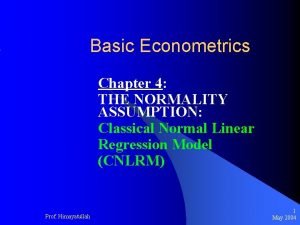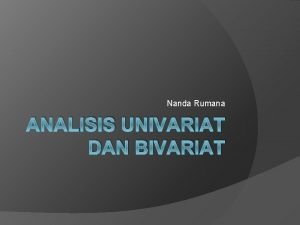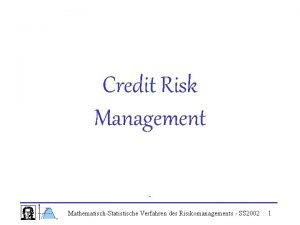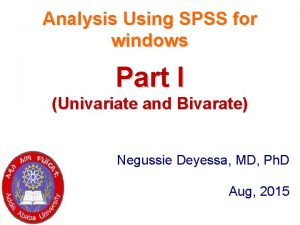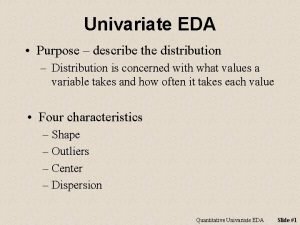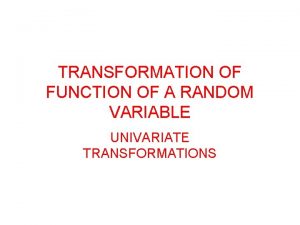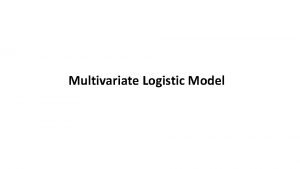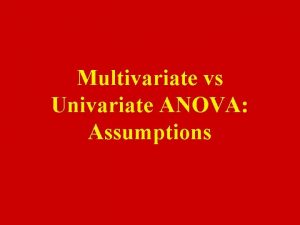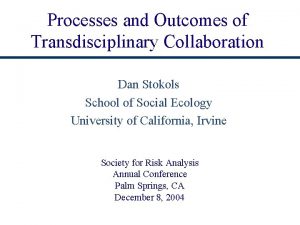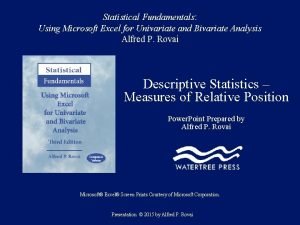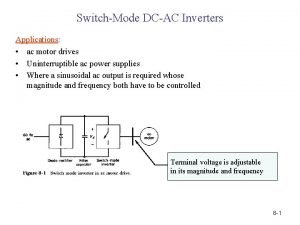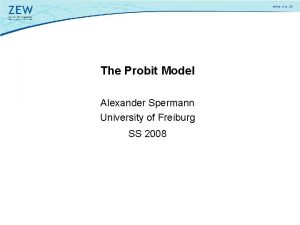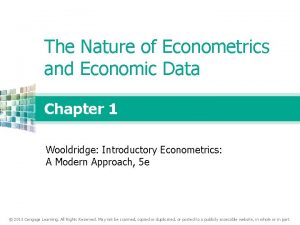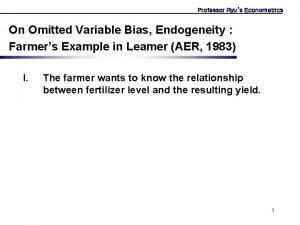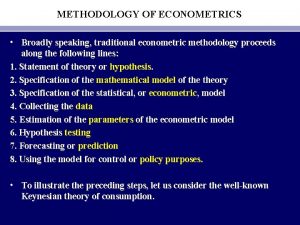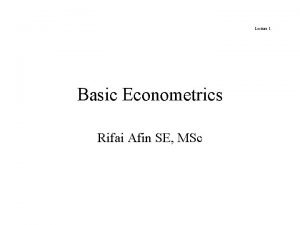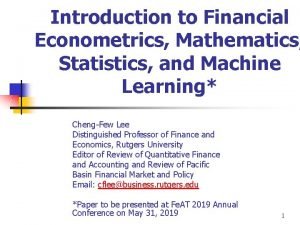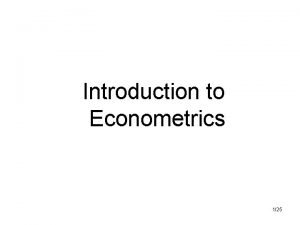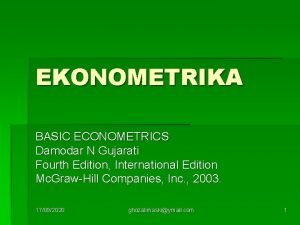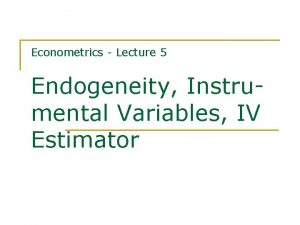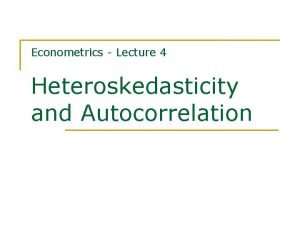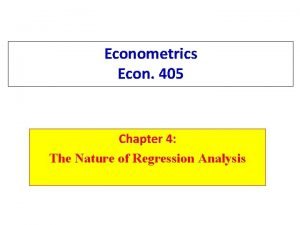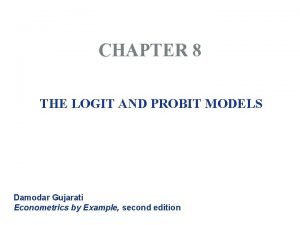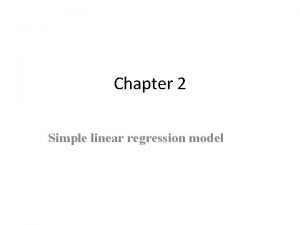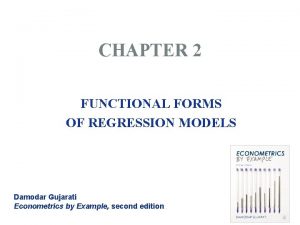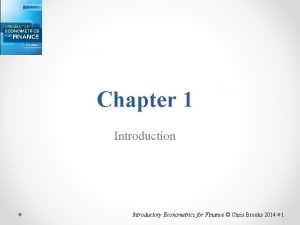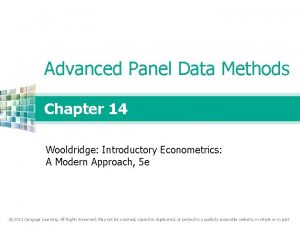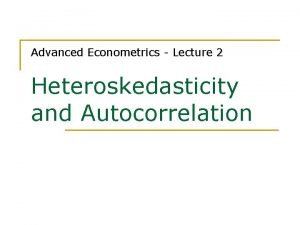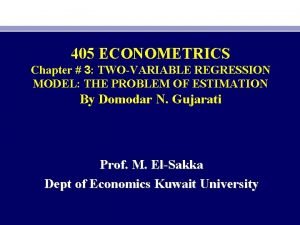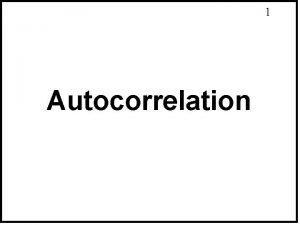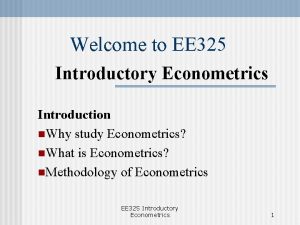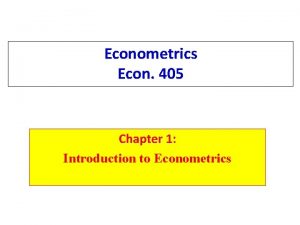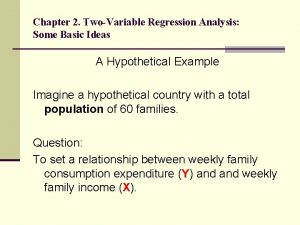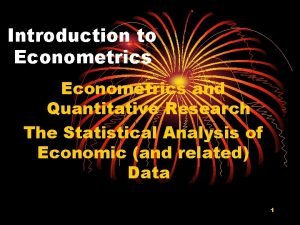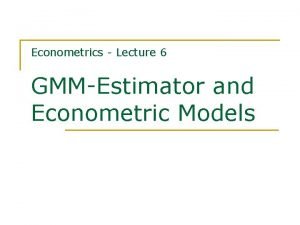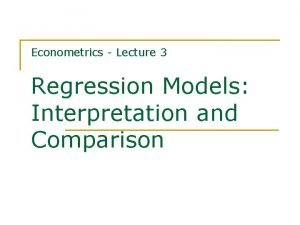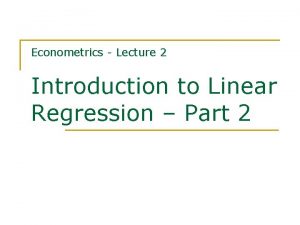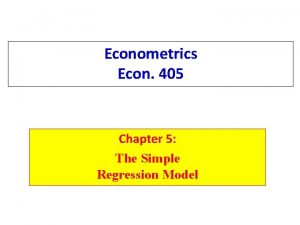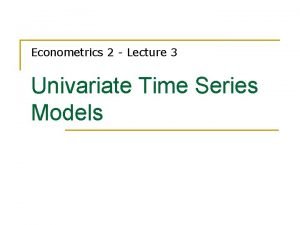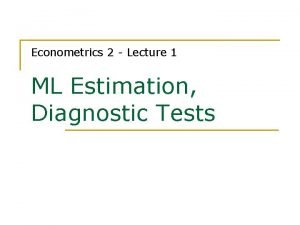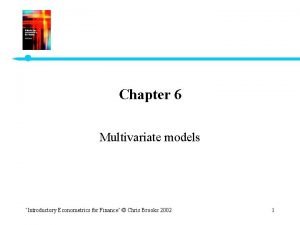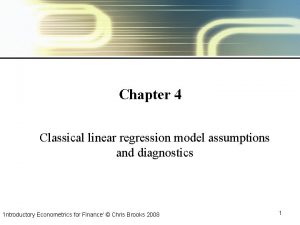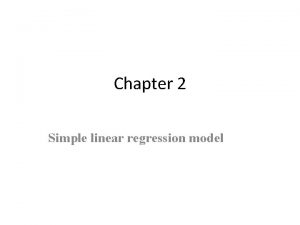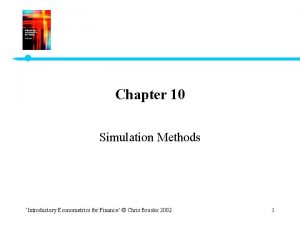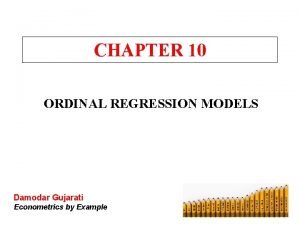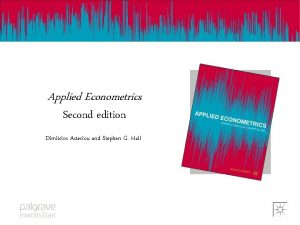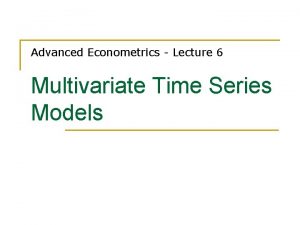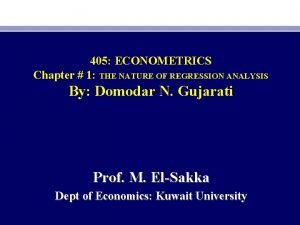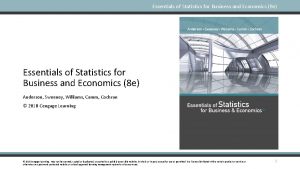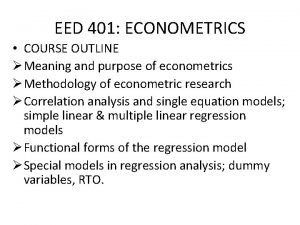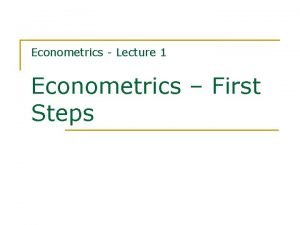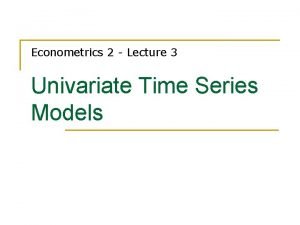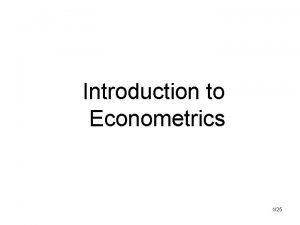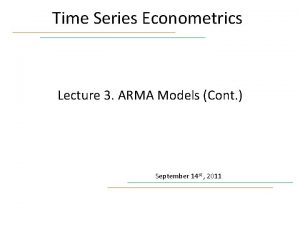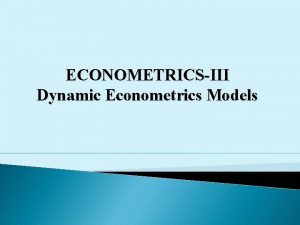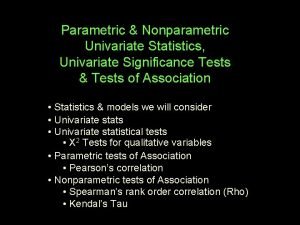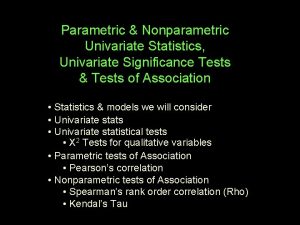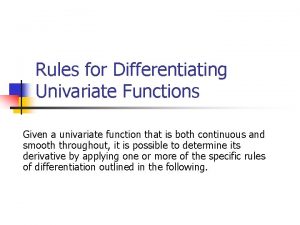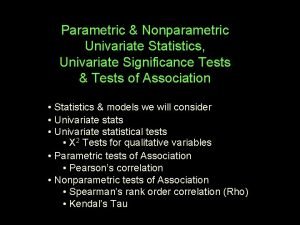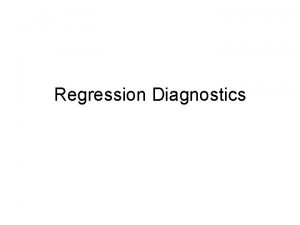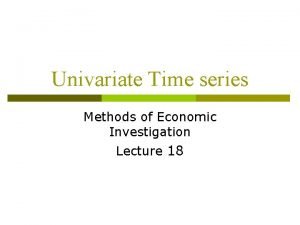Econometrics 2 Lecture 3 Univariate Time Series Models








































































- Slides: 72

Econometrics 2 - Lecture 3 Univariate Time Series Models

Contents n n n n Time Series Stochastic Processes Stationary Processes The ARMA Process Deterministic and Stochastic Trends Models with Trend Unit Root Tests Estimation of ARMA Models April 1, 2016 Hackl, Econometrics 2, Lecture 3 2

Private Consumption Private consumption in the EURO area (16 members), quarterly data, seasonally adjusted, AWM database (in Mio. EUR) April 1, 2016 Hackl, Econometrics 2, Lecture 3 3

Private Consumption: Growth Rate Yearly growth of private consumption in EURO area (16 members), AWM database (in Mio. EUR) Mean growth: 15. 008 April 1, 2016 Hackl, Econometrics 2, Lecture 3 4

Disposable Income Disposable income, Austria (in Mio EUR) April 1, 2016 Hackl, Econometrics 2, Lecture 3 5

Time Series Time-ordered sequence of observations of a random variable Examples: n Annual values of private consumption n Yearly changes in expenditures on private consumption n Quarterly values of personal disposable income n Monthly values of imports Notation: n Random variable Y n Sequence of observations Y 1, Y 2, . . . , YT n Deviations from the mean: yt = Yt – E{Yt} = Yt – μ April 1, 2016 Hackl, Econometrics 2, Lecture 3 6

Components of a Time Series Components or characteristics of a time series are n Trend n Seasonality n Irregular fluctuations Time series model: represents the characteristics as well as possible interactions Purpose of modeling n Description of the time series n Forecasting the future Example: Quarterly observations of the disposable income Yt = βt + Σiγi. Dit + εt with Dit = 1 if t corresponds to i-th quarter, Dit = 0 otherwise April 1, 2016 Hackl, Econometrics 2, Lecture 3 7

Contents n n n n Time Series Stochastic Processes Stationary Processes The ARMA Process Deterministic and Stochastic Trends Models with Trend Unit Root Tests Estimation of ARMA Models April 1, 2016 Hackl, Econometrics 2, Lecture 3 8

Stochastic Process Time series: realization of a stochastic process Stochastic process is a sequence of random variables Yt, e. g. , {Yt, t = 1, . . . , n} {Yt, t = -∞, . . . , ∞} Joint distribution of the Y 1, . . . , Yn: p(y 1, …. , yn) Of special interest n Evolution of the expectation mt = E{Yt} over time n Dependence structure over time Example: Extrapolation of a time series as a tool forecasting April 1, 2016 Hackl, Econometrics 2, Lecture 3 9

White Noise White noise process {Yt, t = -∞, . . . , ∞} n E{Yt} = 0 n V{Yt} = σ² n Cov{Yt, Yt-s} = 0 for all (positive or negative) integers s i. e. , a mean zero, serially uncorrelated, homoskedastic process April 1, 2016 Hackl, Econometrics 2, Lecture 3 10

AR(1)-Process States the dependence structure between consecutive observations as Yt = δ + θYt-1 + εt, |θ| < 1 with εt: white noise, i. e. , V{εt} = σ² (see next slide) n Autoregressive process of order 1 From Yt = δ + θYt-1 + εt = δ + θ²δ +… +εt + θεt-1 + θ²εt-2 +… follows E{Yt} = μ = δ(1 -θ)-1 n |θ| < 1 needed for convergence! Invertibility condition In deviations from μ, yt = Yt – m: yt = θyt-1 + εt April 1, 2016 Hackl, Econometrics 2, Lecture 3 11

AR(1)-Process, cont’d Autocovariances γk = Cov{Yt, Yt-k} n k=0: γ 0 = V{Yt} = θ²V{Yt-1} + V{εt} = … = Σi θ 2 i σ² = σ²(1 -θ²)-1 n k=1: γ 1 = Cov{Yt, Yt-1} = E{ytyt-1} = E{(θyt-1+εt)yt-1} = θV{yt-1} = θσ²(1 -θ²)-1 n In general: γk = Cov{Yt, Yt-k} = θkσ²(1 -θ²)-1, k = 0, ± 1, … depends upon k, not upon t! April 1, 2016 Hackl, Econometrics 2, Lecture 3 12

MA(1)-Process States the dependence structure between consecutive observations as Yt = μ + εt + αεt-1 with εt: white noise, V{εt} = σ² Moving average process of order 1 E{Yt} = μ Autocovariances γk = Cov{Yt, Yt-k} n k=0: γ 0 = V{Yt} = σ²(1+α²) n k=1: γ 1 = Cov{Yt, Yt-1} = ασ² n γk = 0 for k = 2, 3, … n Depends upon k, not upon t! April 1, 2016 Hackl, Econometrics 2, Lecture 3 13

AR-Representation of MAProcess The AR(1) can be represented as MA-process of infinite order yt = θyt-1 + εt = Σ∞i=0 θi εt-i given that |θ| < 1 Similarly: the AR representation of the MA(1) process yt = αyt-1 – α²yt-2 ± … + εt = Σ∞i=0 (-1)i αi+1 yt-i-1 + εt given that |α| < 1 April 1, 2016 Hackl, Econometrics 2, Lecture 3 14

Contents n n n n Time Series Stochastic Processes Stationary Processes The ARMA Process Deterministic and Stochastic Trends Models with Trend Unit Root Tests Estimation of ARMA Models April 1, 2016 Hackl, Econometrics 2, Lecture 3 15

Stationary Processes Refers to the joint distribution of Yt’s, in particular to second moments (Weak) stationary or covariance stationary process: the first two moments are finite and not affected by a shift of time E{Yt} = μ for all t Cov{Yt, Yt+k} = γk, k = 0, ± 1, … for all t and all k Cov{Yt, Yt+k}, k = 0, ± 1, …: covariance function; γt, k = γt, -k A process is called strictly stationary if its stochastic properties are unaffected by a change of the time origin n The joint probability distribution at any set of times is not affected by an arbitrary shift along the time axis April 1, 2016 Hackl, Econometrics 2, Lecture 3 16

AC and PAC Function Autocorrelation function (AC function, ACF) Independent of the scale of Y n For a stationary process: ρk = Corr{Yt, Yt-k} = γk/γ 0, k = 0, ± 1, … n Properties: q q q |ρk| ≤ 1 ρk = ρ-k ρ0 = 1 Correlogram: graphical presentation of the AC function Partial autocorrelation function (PAC function, PACF): θkk = Corr{Yt, Yt-k|Yt-1, . . . , Yt-k+1}, k = 0, ± 1, … n θkk is obtained from Yt = θk 0 + θk 1 Yt-1 +. . . + θkk. Yt-k n Partial correlogram: graphical representation of the PAC function n April 1, 2016 Hackl, Econometrics 2, Lecture 3 17

Examples for the AC and PAC functions: n White noise ρ0 = θ 00 = 1 ρk = θkk = 0, if k ≠ 0 white noise is stationary n AR(1) process, Yt = δ + θYt-1 + εt ρk = θk, k = 0, ± 1, … θ 00 = 1, θ 11 = θ, θkk = 0 for k > 1 n MA(1) process, Yt = μ + εt + αεt-1 ρ0 = 1, ρ1 = α/(1 + α 2), ρk = 0 for k > 1 PAC function: damped exponential if α > 0, alternating and damped exponential if α < 0 April 1, 2016 Hackl, Econometrics 2, Lecture 3 18

Stationarity of MA- and ARProcesses MA processes are stationary n Weighted sum of white noises n E. g. , MA(1) process: Yt = μ + εt + αεt-1 ρ0 = 1, ρ1 = α/(1 + α 2), ρk = 0 for k > 1 An AR process is stationary if it is invertible n AR(1) process, Yt = θYt-1 + εt = Σ∞i=0 θi εt-i if |θ| < 1 (invertibility condition) ρk = θk, k = 0, ± 1, … April 1, 2016 Hackl, Econometrics 2, Lecture 3 19

AC and PAC Function: Estimates n Estimator for the AC function ρk: n Estimator for the PAC function θkk: coefficient of Yt-k in the regression of Yt on Yt-1, …, Yt-k April 1, 2016 Hackl, Econometrics 2, Lecture 3 20

AR(1) Processes, April 1, 2016 Verbeek, Fig. 8. 1 Hackl, Econometrics 2, Lecture 3 21

MA(1) Processes, April 1, 2016 Verbeek, Fig. 8. 2 Hackl, Econometrics 2, Lecture 3 22

Contents n n n n Time Series Stochastic Processes Stationary Processes The ARMA Process Deterministic and Stochastic Trends Models with Trend Unit Root Tests Estimation of ARMA Models April 1, 2016 Hackl, Econometrics 2, Lecture 3 23

The ARMA(p, q) Process Generalization of the AR and MA processes: ARMA(p, q) process yt = θ 1 yt-1 + … + θpyt-p + εt + α 1εt-1 + … + αqεt-q with white noise εt Lag (or shift) operator L (Lyt = yt-1, L 0 yt = Iyt = yt, Lpyt = yt-p) ARMA(p, q) process in operator notation θ(L)yt = α(L)εt with operator polynomials θ(L) and α(L) θ(L) = I - θ 1 L - … - θp. Lp α(L) = I + α 1 L + … + αq. Lq April 1, 2016 Hackl, Econometrics 2, Lecture 3 24

Lag Operator Lag (or shift) operator L n Lyt = yt-1, L 0 yt = Iyt = yt, Lpyt = yt-p n Algebra of polynomials in L like algebra of variables Examples: n (I - ϕ 1 L)(I - ϕ 2 L) = I – (ϕ 1+ ϕ 2)L + ϕ 1ϕ 2 L 2 n (I - θL)-1 = Σ∞i=0θi Li n MA(∞) representation of the AR(1) process yt = (I - θL)-1εt the infinite sum defined only (e. g. , finite variance) if |θ| < 1 n MA(∞) representation of the ARMA(p, q) process yt = [θ (L)]-1α(L)εt similarly the AR(∞) representations; invertibility condition: restrictions on parameters April 1, 2016 Hackl, Econometrics 2, Lecture 3 25

Invertibility of Lag Polynomials Invertibility condition for lag polynomial θ(L) = I - θL: |θ| < 1 Invertibility condition for lag polynomial of order 2, θ(L) = I - θ 1 L - θ 2 L 2 n θ(L) = I - θ 1 L - θ 2 L 2 = (I - ϕ 1 L)(I - ϕ 2 L) with ϕ 1+ϕ 2 = θ 1 and -ϕ 1ϕ 2 = θ 2 n Invertibility conditions: both (I – ϕ 1 L) and (I – ϕ 2 L) invertible; |ϕ 1| < 1, |ϕ 2| < 1 Invertibility in terms of the characteristic equation θ(z) = (1 - ϕ 1 z) (1 - ϕ 2 z) = 0 n Characteristic roots: solutions z 1, z 2 from (1 - ϕ 1 z) (1 - ϕ 2 z) = 0 z 1 = ϕ 1 -1, z 2 = ϕ 2 -1 n Invertibility conditions: |z 1| = |ϕ 1 -1| > 1, |z 2| = |ϕ 2 -1| > 1 Polynomial θ(L) is not invertible if any solution zi fulfills |zi| ≤ 1 Can be generalized to lag polynomials of higher order April 1, 2016 Hackl, Econometrics 2, Lecture 3 26

Unit Root and Invertibility Lag polynomial of order 1: θ(z) = (1 - θz) = 0, n Unit root: characteristic root z = 1; implies θ = 1 n Invertibility condition |θ| < 1 is violated, AR process Yt = θYt-1 + εt is non-stationary Lag polynomial of order 2 n Characteristic equation θ(z) = (1 - ϕ 1 z) (1 - ϕ 2 z) = 0 n Characteristic roots zi = 1/ϕi, i = 1, 2 n Unit root: a characteristic root zi of value 1; violates the invertibility condition |z 1| = |ϕ 1 -1| > 1, |z 2| = |ϕ 2 -1| > 1 n AR(2) process Yt is non-stationary AR(p) process: polynomial θ(z) = 1 - θ 1 z - … - θp. Lp, evaluated at z = 1, is zero, given Σiθi = 1: Σiθi = 1 indicates a unit root Tests for unit roots are important tools for identifying stationarity April 1, 2016 Hackl, Econometrics 2, Lecture 3 27

Contents n n n n Time Series Stochastic Processes Stationary Processes The ARMA Process Deterministic and Stochastic Trends Models with Trend Unit Root Tests Estimation of ARMA Models April 1, 2016 Hackl, Econometrics 2, Lecture 3 28

Types of Trend: The development of the expected value of a process over time; typically an increasing (or decreasing) pattern n Deterministic trend: a function f(t) of the time, describing the evolution of E{Yt} over time Yt = f(t) + εt, εt: white noise Example: Yt = α + βt + εt describes a linear trend of Y; an increasing trend corresponds to β > 0 n Stochastic trend: Yt = δ + Yt-1 + εt or ΔYt = Yt – Yt-1 = δ + εt, εt: white noise q q q describes an irregular or random fluctuation of the differences ΔYt around the expected value δ AR(1) – or AR(p) – process with unit root “random walk with trend” April 1, 2016 Hackl, Econometrics 2, Lecture 3 29

Example: Private Consumption Private consumption, AWM database; level values (PCR) and first differences (PCR_D) Mean of PCD_D: 3740 April 1, 2016 Hackl, Econometrics 2, Lecture 3 30

Trends: Random Walk and AR Process Random walk: Yt = Yt-1 + εt; random walk with trend: Yt = 0. 1 +Yt-1 + εt; AR(1) process: Yt = 0. 2 + 0. 7 Yt-1 + εt; εt simulated from N(0, 1) 20 16 12 8 4 0 -4 -8 -12 10 20 30 40 50 60 70 80 90 100 random walk with trend AR(1) process, δ=0. 2, θ=0. 7 April 1, 2016 Hackl, Econometrics 2, Lecture 3 31

Random Walk with Trend The random walk with trend Yt = δ + Yt-1 + εt can be written as Yt = Y 0 + δt + Σi≤t εi δ: trend parameter Components of the process n Deterministic growth path Y 0 + δt n Cumulative errors Σi≤t εi Properties: n Expectation Y 0 + δt is depending on Y 0, i. e. , on the origin (t=0)! n V{Yt} = σ²t becomes arbitrarily large! n Corr{Yt, Yt-k} = √(1 -k/t) n Random walk with trend is non-stationary! April 1, 2016 Hackl, Econometrics 2, Lecture 3 32

Random Walk with Trend, cont’d From Corr{Yt, Yt-k} = √(1 -k/t) follows n For fixed k, Yt and Yt-k are the stronger correlated, the larger t n With increasing k, correlation tends to zero, but the slower the larger t (long memory property) Comparison of random walk with the AR(1) process Yt = δ + θYt-1 + εt n AR(1) process: εt-i has the lesser weight, the larger i n AR(1) process similar to random walk when θ is close to one April 1, 2016 Hackl, Econometrics 2, Lecture 3 33

Non-Stationarity: Consequences AR(1) process Yt = θYt-1 + εt n OLS estimator for θ: n For |θ| < 1: the estimator is q q n consistent asymptotically normally distributed For θ = 1 (unit root) q q q θ is underestimated estimator not normally distributed spurious regression problem April 1, 2016 Hackl, Econometrics 2, Lecture 3 34

Integrated Processes In order to cope with non-stationarity n Trend-stationary process: the process can be transformed in a stationary process by subtracting the deterministic trend q n E. g. , Yt = f(t) + εt with white noise εt: Yt–f(t) = εt is stationary Difference-stationary process, or integrated process: stationary process can be derived by differencing q E. g. , Yt = δ + Yt-1 + εt, E. g. , Yt–Yt-1 = δ + εt is stationary Integrated process: stochastic process Y is called n integrated of order one if the first difference yield a stationary process: Y ~ I(1) n integrated of order d, if the d-fold differences yield a stationary process: Y ~ I(d) April 1, 2016 Hackl, Econometrics 2, Lecture 3 35

I(0)- vs. I(1)-Processes I(0) process, e. g. , Yt = δ + εt n Fluctuates around the process mean with constant variance q q Mean-reverting Limited memory I(1) process e. g. , Yt = δ + Yt-1 + εt n Fluctuates widely q q Infinitely long memory Persistent effect of shocks April 1, 2016 Hackl, Econometrics 2, Lecture 3 36

Integrated Stochastic Processes Many economic time series show stochastic trends From the AWM Database Variable d YER GDP, real 1 PCR Consumption, real 1 -2 PYR Household's Disposable Income, real 1 -2 PCD Consumption Deflator 2 ARIMA(p, d, q) process: d-th differences follow an ARMA(p, q) process April 1, 2016 Hackl, Econometrics 2, Lecture 3 37

Contents n n n n Time Series Stochastic Processes Stationary Processes The ARMA Process Deterministic and Stochastic Trends Models with Trend Unit Root Tests Estimation of ARMA Models April 1, 2016 Hackl, Econometrics 2, Lecture 3 38

Example: Model for a Stochastic Trend Data generation: random walk (without trend): Yt = Yt-1 + εt, εt: white noise n Realization of Yt: is a non-stationary process, stochastic trend n V{Yt}: a multiple of t Specified model: Yt = α + βt + εt n Deterministic trend n Constant variance n Miss-specified model! Consequences for OLS estimator for β n t- and F-statistics: wrong critical limits, rejection probability too large n R 2 indicates explanatory potential although Yt random walk without trend n “spurious regression” or “nonsense regression” April 1, 2016 Hackl, Econometrics 2, Lecture 3 39

White Noise and Random Walk Computer-generated random numbers n eps: white noise, i. e. , N(0, 1)-distributed n Y: random walk Yt = Yt-1 + epst April 1, 2016 Hackl, Econometrics 2, Lecture 3 40

Random Walk and Deterministic Trend Fitting the deterministic trend model Yt = α + βt + εt to the random walk data results in -0. 92 +0. 096 t with t-statistic 19. 77 for b, R 2 = 0. 66, and Durbin Watson statistic 0. 066 April 1, 2016 Hackl, Econometrics 2, Lecture 3 41

How to Model Trends? Specification of n Deterministic trend, e. g. , Yt = α + βt + εt: risk of spurious regression, wrong decisions n Stochastic trend: analysis of differences ΔYt if a random walk, i. e. , a unit root, is suspected Consequences of spurious regression are more serious Consequences of modeling differences ΔYt: n Autocorrelated errors n Consistent estimators n Asymptotically normally distributed estimators n HAC correction of standard errors, i. e. , heteroskedasticity and autocorrelation consistent estimates of standard errors April 1, 2016 Hackl, Econometrics 2, Lecture 3 42

Elimination of Trend Random walk Yt = δ + Yt-1 + εt with white noise εt ΔYt = Yt – Yt-1 = δ + εt n ΔYt is a stationary process n A random walk is a difference-stationary or I(1) process Linear trend Yt = α + βt + εt n Subtracting the trend component α + βt provides a stationary process n Yt is a trend-stationary process April 1, 2016 Hackl, Econometrics 2, Lecture 3 43

Contents n n n n Time Series Stochastic Processes Stationary Processes The ARMA Process Deterministic and Stochastic Trends Models with Trend Unit Root Tests Estimation of ARMA Models April 1, 2016 Hackl, Econometrics 2, Lecture 3 44

Unit Root Tests AR(1) process Yt = δ + θYt-1 + εt with white noise εt n Dickey-Fuller or DF test (Dickey & Fuller, 1979) Test of H 0: θ = 1 against H 1: θ < 1, i. e. , H 0 states Y ~ I(1), Y is nonstationary n KPSS test (Kwiatkowski, Phillips, Schmidt & Shin, 1992) Test of H 0: θ < 1 against H 1: θ = 1, i. e. , H 0 states Y ~ I(0), Y is stationary n Augmented Dickey-Fuller or ADF test extension of DF test n Various modifications like Phillips-Perron test, Dickey-Fuller GLS test, etc. April 1, 2016 Hackl, Econometrics 2, Lecture 3 45

Dickey-Fuller‘s Unit Root Test AR(1) process Yt = δ + θYt-1 + εt with white noise εt OLS Estimator for θ: Test statistic Distribution of DF n If |θ| < 1: approximately t(T-1) n If θ = 1: Dickey & Fuller critical values DF test for testing H 0: θ = 1 against H 1: θ < 1 n θ = 1: characteristic equation 1 – θz = 0 has unit root April 1, 2016 Hackl, Econometrics 2, Lecture 3 46

Dickey-Fuller Critical Values Monte Carlo estimates of critical values for DF 0: Dickey-Fuller test without intercept; Yt = θYt-1 + εt DF: Dickey-Fuller test with intercept; Yt = δ + θYt-1 + εt DFτ: Dickey-Fuller test with time trend; Yt = δ + γt + θYt-1 + εt T 25 100 p = 0. 01 p = 0. 05 p = 0. 10 DF 0 -2. 66 -1. 95 -1. 60 DF -3. 75 -3. 00 -2. 63 DFτ -4. 38 -3. 60 -3. 24 DF 0 -2. 60 -1. 95 -1. 61 DF -3. 51 -2. 89 -2. 58 DFτ -4. 04 -3. 45 -3. 15 -2. 33 -1. 65 -1. 28 N(0, 1) April 1, 2016 Hackl, Econometrics 2, Lecture 3 47

Unit Root Test: The Practice AR(1) process Yt = δ + θYt-1 + εt with white noise εt can be written with π = θ -1 as ΔYt = δ + πYt-1 + εt DF tests H 0: π = 0 against H 1: π < 0 test statistic for testing π = θ -1 = 0 identical with DF statistic Two steps: 1. Regression of ΔYt on Yt-1: OLS-estimator for π = θ - 1 2. Test of H 0: π = 0 against H 1: π < 0 based on DF; critical values of Dickey & Fuller April 1, 2016 Hackl, Econometrics 2, Lecture 3 48

Example: Price/Earnings Ratio Verbeek’s data set PE: annual time series data on composite stock price and earnings indices of the S&P 500, 1871 -2002 n PE: price/earnings ratio q q n Mean 14. 6 Min 6. 1 Max 36. 7 St. Dev. 5. 1 log(PE) q q Mean 2. 63 Min 1. 81 Max 3. 60 St. Dev. 0. 33 April 1, 2016 Hackl, Econometrics 2, Lecture 3 49

Price/Earnings Ratio, cont’d Fitting an AR(1) process to the log(PE) data gives: ΔYt = 0. 335 – 0. 125 Yt-1 with t-statistic -2. 569 (for Yt-1) and p-value 0. 1021 n p-value of the DF statistic (-2. 569): 0. 102 q q q 1% critical value: -3. 48 5% critical value: -2. 88 10% critical value: -2. 58 H 0: θ = 1 (non-stationarity) cannot be rejected for the log(PE) Unit root test for first differences: ΔΔYt = 0. 008 – 0. 9935ΔYt-1, DF statistic -10. 59, p-value 0. 000 (1% critical value: -3. 48) n log(PE) is I(1) However: for sample 1871 -1990: DF statistic -3. 65, p-value 0. 006; within the period 1871 -1990, the log(PE) is stationary n April 1, 2016 Hackl, Econometrics 2, Lecture 3 50

Unit Root Test: Extensions DF test so far for a model with intercept: ΔYt = δ + πYt-1 + εt Tests for alternative or extended models n DF test for model without intercept: ΔYt = πYt-1 + εt n DF test for model with intercept and trend: ΔYt = δ + γt + πYt-1 + εt DF tests in all cases H 0: π = 0 against H 1: π < 0 Test statistic in all cases Critical values depend on cases; cf. Table on slide 47 April 1, 2016 Hackl, Econometrics 2, Lecture 3 51

KPSS Test Process Yt = βt + (rt + α) + εt, with deterministic time trend βt, a random walk rt = rt-1 + ut with white noise ut with variance σu 2, r 0 = α serving as intercept, and white noise error term εt n Test of H 0: σu 2 = 0, i. e. , (Yt is trend stationary, or Yt-βt is stationary), against H 1: σu 2 > 0 n H 0 implies a unit moving average root in the ARMA representation of ΔYt n KPSS (Kwiatkowski, Phillips, Schmidt, Shin) test statistic n n with St = Σti=1 ei and the variance estimate s 2 of the residuals et from the regression Yt = δ + βt + εt Reject H 0 for large values of KPSS Critical values from Monte Carlo simulations April 1, 2016 Hackl, Econometrics 2, Lecture 3 52

ADF Test Extended model according to an AR(p) process: ΔYt = δ + πYt-1 + β 1ΔYt-1 + … + βpΔYt-p+1 + εt Example: AR(2) process Yt = δ + θ 1 Yt-1 + θ 2 Yt-2 + εt can be written as ΔYt = δ + (θ 1+ θ 2 - 1)Yt-1 – θ 2ΔYt-1 + εt the characteristic equation (1 - ϕ 1 L)(1 - ϕ 2 L) = 0 has roots θ 1 = ϕ 1 + ϕ 2 and θ 2 = - ϕ 1ϕ 2 a unit root implies ϕ 1 = θ 1+ θ 2 =1: Augmented DF (ADF) test n Test of H 0: π = 0 , i. e. , Y ~ I(1), against H 1: π < 0 n Critical values from simulations n Extensions (intercept, trend) similar to the DF-test n Phillips-Perron test: alternative method; uses HAC-corrected standard errors April 1, 2016 Hackl, Econometrics 2, Lecture 3 53

Price/Earnings Ratio, cont’d Extended model according to an AR(2) process gives: ΔYt = 0. 366 – 0. 136 Yt-1 + 0. 152ΔYt-1 - 0. 093ΔYt-2 with t-statistics -2. 487 (Yt-1), 1. 667 (ΔYt-1) and -1. 007 (ΔYt-2) and p-values 0. 119, 0. 098 and 0. 316 n p-value of the DF statistic 0. 121 q q q 1% critical value: -3. 48 5% critical value: -2. 88 10% critical value: -2. 58 Non-stationarity cannot be rejected for the log(PE) Unit root test for first differences: DF statistic -7. 31, p-value 0. 000 (1% critical value: -3. 48) n log(PE) is I(1) However: for sample 1871 -1990: DF statistic -3. 52, p-value 0. 009 n April 1, 2016 Hackl, Econometrics 2, Lecture 3 54

Unit Root Tests in GRETL For marked variable: n Variable > Unit root tests > Augmented Dickey. Fuller test Performs the q q q n Variable > Unit root tests > ADF-GLS test Performs the q q q n DF test (choose zero for “lag order for ADF test”) or the ADL test with or without constant, trend, squared trend DF test (choose zero for “lag order for ADF test”) or the ADL test with or without a trend, which are estimated by GLS Variable > Unit root tests > KPSS test Performs the KPSS test with or without a trend April 1, 2016 Hackl, Econometrics 2, Lecture 3 55

Contents n n n n Time Series Stochastic Processes Stationary Processes The ARMA Process Deterministic and Stochastic Trends Models with Trend Unit Root Tests Estimation of ARMA Models April 1, 2016 Hackl, Econometrics 2, Lecture 3 56

ARMA Models: Application of the ARMA(p, q) model in data analysis: Three steps 1. Model specification, i. e. , choice of p, q (and d if an ARIMA model is specified) 2. Parameter estimation 3. Diagnostic checking April 1, 2016 Hackl, Econometrics 2, Lecture 3 57

Estimation of ARMA Models The estimation methods n OLS estimation n ML estimation AR models n Explanatory variables are lagged values of the explained variable n Uncorrelated with error term n OLS estimation April 1, 2016 Hackl, Econometrics 2, Lecture 3 58

MA Models: OLS Estimation MA models: n Minimization of sum of squared deviations is not straightforward n E. g. , for an MA(1) model, S(μ, α) = Σt[Yt - μ - αΣj=0(- α)j(Yt-j-1 – μ)]2 q q S(μ, α) is a nonlinear function of parameters Needs Yt-j-1 for j=0, 1, …, i. e. , historical Ys, s < 0 Approximate solution from minimization of S*(μ, α) = Σt[Yt - μ - αΣj=0 t-2(- α)j(Yt-j-1 – μ)]2 n Nonlinear minimization, grid search ARMA models combine AR part with MA part n April 1, 2016 Hackl, Econometrics 2, Lecture 3 59

ML Estimation Assumption of normally distributed εt Log likelihood function, conditional on initial values log L(α, θ, μ, σ²) = - [(T-1)/2] log(2πσ²) – (2σ²)-1 Σt εt² εt are functions of the parameters n AR(1): εt = yt - θ 1 yt-1 n MA(1): εt = Σj=0 t-1(- α)jyt-j Initial values: y 1 for AR, ε 0 = 0 for MA n Extension to exact ML estimator n Again, estimation for AR models easier n ARMA models combine AR part with MA part April 1, 2016 Hackl, Econometrics 2, Lecture 3 60

Model Specification Based on the n Autocorrelation function (ACF) n Partial Autocorrelation function (PACF) Structure of AC and PAC functions typical for AR and MA processes Example: n MA(1) process: ρ0 = 1, ρ1 = α/(1 -α²); ρi = 0, i = 2, 3, …; θkk = αk, k = 0, 1, … n AR(1) process: ρk = θk, k = 0, 1, …; θ 00 = 1, θ 11 = θ, θkk = 0 for k > 1 Empirical ACF and PACF give indications on the process underlying the time series April 1, 2016 Hackl, Econometrics 2, Lecture 3 61

ARMA(p, q)-Processes April 1, 2016 Condition for AR(p) θ(L)Yt = εt MA(q) Yt = α(L) εt Stationarity roots zi of always stationary θ(z)=0: |zi| > 1 Invertibility always invertible roots zi of α(z)=0: |zi| > 1 AC function damped, infinite rk = 0 for k > q damped, infinite PAC function θkk = 0 for k > p damped, infinite Hackl, Econometrics 2, Lecture 3 ARMA(p, q) θ(L)Yt=α(L) εt 62

Empirical AC and PAC Function Estimation of the AC and PAC functions AC ρk: PAC θkk: coefficient of Yt-k in regression of Yt on Yt-1, …, Yt-k MA(q) process: standard errors for rk, k > q, from √T(rk – ρk) → N(0, vk) with vk = 1 + 2ρ1² + … + 2ρk² n test of H 0: ρ1 = 0, i. e. , model is MA(0): compare √Tr 1 with critical value from N(0, 1), etc. AR(p) process: test of H 0: ρk = 0 for k > p based on asymptotic distribution April 1, 2016 Hackl, Econometrics 2, Lecture 3 63

Diagnostic Checking ARMA(p, q): Adequacy of choices p and q Analysis of residuals from fitted model: n Correct specification: residuals are realizations of white noise n Box-Ljung Portmanteau test: for a ARMA(p, q) process follows the Chi-squared distribution with K-p-q df Overfitting n Starting point: a general model n Comparison with a model with reduced number of parameters: choose model with smallest BIC or AIC n AIC: tends to result asymptotically in overparameterized models April 1, 2016 Hackl, Econometrics 2, Lecture 3 64

Example: Price/Earnings Ratio Data set PE: PE = price/earnings n log(PE) q q Mean 2. 63 Min 1. 81 Max 3. 60 Std 0. 33 April 1, 2016 Hackl, Econometrics 2, Lecture 3 65

PE Ratio: AC and PAC Function At level 0. 05 significant values: § ACF: k = 4 § PACF: k = 2, 4 possibly MA(4) (ACFk=0 if k>4) or AR(4) Sample ACF and PACF of log(PEt) - log(PEt-1) April 1, 2016 Hackl, Econometrics 2, Lecture 3 66

PE Ratio: MA (4) Model MA(4) model for differences log(PEt) – log(PEt-1), LOGPE = log(PE) Function evaluations: 37 Evaluations of gradient: 11 Model 2: ARMA, using observations 1872 -2002 (T = 131) Estimated using Kalman filter (exact ML) Dependent variable: d_LOGPE Standard errors based on Hessian coefficient std. error t-ratio --------------------------- const 0, 00804276 0, 0104120 0, 7725 theta_1 0, 0478900 0, 0864653 0, 5539 theta_2 -0, 187566 0, 0913502 -2, 053 theta_3 -0, 0400834 0, 0819391 -0, 4892 theta_4 -0, 146218 0, 0915800 -1, 597 Mean dependent var Mean of innovations Log-likelihood Schwarz criterion April 1, 2016 0, 008716 -0, 000308 42, 69439 -56, 13759 p-value 0, 4398 0, 5797 0, 0400 ** 0, 6247 0, 1104 S. D. dependent var S. D. of innovations Akaike criterion Hannan-Quinn Hackl, Econometrics 2, Lecture 3 0, 181506 0, 174545 -73, 38877 -66, 37884 67

PE Ratio: AR(4) Model AR(4) model for differences log(PEt) – log(PEt-1), LOGPE = log(PE) Function evaluations: 36 Evaluations of gradient: 9 Model 3: ARMA, using observations 1872 -2002 (T = 131) Estimated using Kalman filter (exact ML) Dependent variable: d_LOGPE Standard errors based on Hessian coefficient std. error t-ratio --------------------------- const 0, 00842210 0, 0111324 0, 7565 phi_1 0, 0601061 0, 0851737 0, 7057 phi_2 -0, 202907 0, 0856482 -2, 369 phi_3 -0, 0228251 0, 0853236 -0, 2675 phi_4 -0, 206655 0, 0850843 -2, 429 Mean dependent var Mean of innovations Log-likelihood Schwarz criterion April 1, 2016 0, 008716 -0, 000315 43, 35448 -57, 45778 p-value 0, 4493 0, 4804 0, 0178 ** 0, 7891 0, 0151 ** S. D. dependent var S. D. of innovations Akaike criterion Hannan-Quinn Hackl, Econometrics 2, Lecture 3 0, 181506 0, 173633 -74, 70896 -67, 69903 68

PE Ratio: Various Models Diagnostics for various competing models: Δyt = log(PEt) – log(PEt-1) Best fit for n BIC: MA(2) model Δyt = 0. 008 + et – 0. 250 et-2 n AIC: AR(2, 4) model Δyt = 0. 008 – 0. 202 Δyt-2 – 0. 211 Δyt-4 + et April 1, 2016 Model Lags AIC MA(4) 1 -4 -73. 389 -56. 138 5. 03 0. 957 AR(4) 1 -4 -74. 709 -57. 458 3. 74 0. 988 MA 2, 4 -76. 940 -65. 440 5. 48 0. 940 AR 2, 4 -78. 057 -66. 556 4. 05 0. 982 MA 2 -76. 072 -67. 447 9. 30 0. 677 AR 2 -73. 994 -65. 368 12. 12 0. 436 BIC Hackl, Econometrics 2, Lecture 3 Q 12 p-value 69

Time Series Models in GRETL Variable > Unit root tests > (a) Augmented Dickey. Fuller test, (b) ADF-GLS test, (c) KPSS test a) DF test or ADF test with or without constant, trend and squared trend b) DF test or ADF test with or without trend, GLS estimation for demeaning and detrending c) KPSS (Kwiatkowski, Phillips, Schmidt, Shin) test Model > Time Series > ARIMA n Estimates an ARMA model, with or without exogenous regressors April 1, 2016 Hackl, Econometrics 2, Lecture 3 70

Your Homework 1. Use Greene’s data set GREENE 18_1 (Corporate bond yields, 1990: 01 to 1994: 12) and answer the following questions for the variable YIELD (yield on Moody’s Aaa rated corporate bond). a) Using the model-statement “Ordinary Least Squares …” in Gretl, (i) estimate the standard Dickey-Fuller regression with intercept and compute the DF test statistics for a unit root. What do you conclude about the presence of a unit root, about stationarity of YIELD? b) Produce a graph of YIELD. Interpret the graph in view of the results of a). c) Using Gretl, conduct ADF tests including (i) with and (ii) without a linear trend, and (iii) with seasonal dummies. What do you conclude about the presence of a unit root? Compare the results with those of a). d) Transform YIELD into its first differences d_YIELD. Repeat c) for the differences. What do you conclude? e) Determine the sample ACF and PACF for YIELD. What orders of the ARMA model for YIELD is suggested by these graphs? April 1, 2016 Hackl, Econometrics 2, Lecture 3 71

Your Homework e) Estimate (i) an AR(1)- and (ii) an AR(2)-model for YIELD. Test for autocorrelation in the residuals of the two models. What do you conclude? 2. For the AR(1) process Yt = θYt-1 + εt with white noise εt, show that (a) the ACF is ρk = θk, k = 0, ± 1, …, and that (b) the PACF is θ 00 = 1, θ 11 = θ, θkk = 0 for k > 1. April 1, 2016 Hackl, Econometrics 2, Lecture 3 72
 Cnlrm
Cnlrm Bmk+
Bmk+ Data univariat dan bivariat
Data univariat dan bivariat Univariate verfahren
Univariate verfahren Univariate analysis spss
Univariate analysis spss Univariate eda
Univariate eda Univariate transformation of random variable
Univariate transformation of random variable Ratio test
Ratio test Univariate anova
Univariate anova What is quasi experimental research
What is quasi experimental research Univariate vs multivariate
Univariate vs multivariate Univariate analysis excel
Univariate analysis excel 01:640:244 lecture notes - lecture 15: plat, idah, farad
01:640:244 lecture notes - lecture 15: plat, idah, farad Geology lecture series
Geology lecture series Dcac lecture series
Dcac lecture series Difference between modals and semi modals
Difference between modals and semi modals Ibm p series
Ibm p series For minutes. start.
For minutes. start. Maclaurin series vs taylor series
Maclaurin series vs taylor series Heisenberg 1925 paper
Heisenberg 1925 paper Taylor vs maclaurin
Taylor vs maclaurin Deret maclaurin
Deret maclaurin Feedback amplifiers
Feedback amplifiers Series aiding and series opposing
Series aiding and series opposing Arithmetic series vs geometric series
Arithmetic series vs geometric series Probit model
Probit model Nature of econometrics
Nature of econometrics Confidence interval econometrics
Confidence interval econometrics Endogeneity econometrics
Endogeneity econometrics Dataset for multiple regression analysis
Dataset for multiple regression analysis Gujarati econometrics
Gujarati econometrics Classical methodology of econometrics
Classical methodology of econometrics Nature and scope of macro economics
Nature and scope of macro economics Afin in gujarati
Afin in gujarati Importance of statistics in finance
Importance of statistics in finance Methodology of econometrics
Methodology of econometrics Gujarati ekonometrika
Gujarati ekonometrika Econometrics machine learning
Econometrics machine learning Endogeneity econometrics
Endogeneity econometrics Autocorrelation in econometrics
Autocorrelation in econometrics Econ 405
Econ 405 Probit econometrics
Probit econometrics Autocorrelation ppt gujarati
Autocorrelation ppt gujarati Prf in econometrics
Prf in econometrics Functional form of regression model
Functional form of regression model Introduction to econometrics for finance
Introduction to econometrics for finance Wooldridge econometrics slides
Wooldridge econometrics slides Autocorrelation in econometrics
Autocorrelation in econometrics Econometrics chapter 3
Econometrics chapter 3 Negative autocorrelation
Negative autocorrelation Methodology of econometrics
Methodology of econometrics Goals of econometrics
Goals of econometrics Econometrics
Econometrics Sample regression function
Sample regression function Real econometrics bailey
Real econometrics bailey Econometrics and quantitative economics
Econometrics and quantitative economics Econometrics
Econometrics Econometrics
Econometrics Econometrics
Econometrics Econometrics simple regression model
Econometrics simple regression model Econometrics
Econometrics Lm test econometrics
Lm test econometrics Wooldridge chapter 6 solutions
Wooldridge chapter 6 solutions Assumptions of the classical linear regression model
Assumptions of the classical linear regression model What is srf in econometrics
What is srf in econometrics Econometrics
Econometrics Damodar gujarati econometrics by example
Damodar gujarati econometrics by example Asteriou and hall applied econometrics pdf
Asteriou and hall applied econometrics pdf Econometrics
Econometrics Statistical versus deterministic relationship
Statistical versus deterministic relationship Business econometrics
Business econometrics Course outline meaning
Course outline meaning Econometrics
Econometrics
